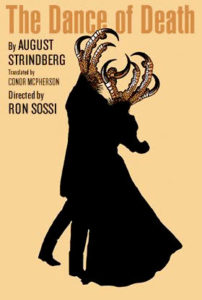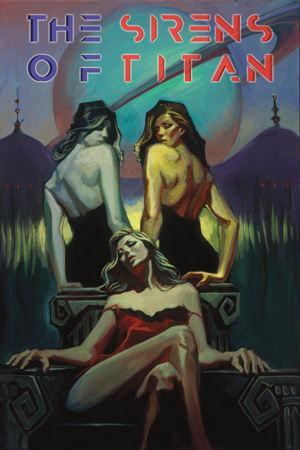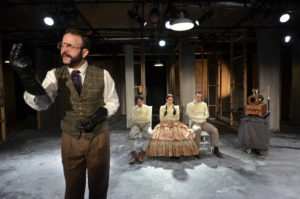
Courtesy The Odyssey Theatre
When a grim year gets grimmer with no end in sight, those down-in-the-mouth over the decaying state of things can look to the arts for a pick-me-up. Pinter, Beckett, Kane… all can offer a glimmer of hope of a better world than our present one. Add Strindberg to this list and visit ‘Dance of Death’ now at The Odyssey in West L.A. until 19 November. Empty nesters Alice and Edgar live in isolation on a small, unnamed Scandinavian island awaiting their silver wedding anniversary. He is a minor military man, detesting all and detested by all in return. She is much younger, having given up a go-nowhere acting career to marry him. Two children and a life together did nothing to brighten twenty-five years of unrelenting mutual hatred.
Conor McPherson‘s 2012 adaptation reduces Strindberg’s original cast to three and a chess match begins immediately. Aging, ailing Edgar (Darrell Larson) and youthful, seething Alice (Lizzy Kimball) aren’t grandmasters but two nonetheless very effective opponents who know each other’s tactics and always have a nasty countermove at the ready. The relentless, active stalemate needs a stimulus and into this domestic prison – their house used to be one – drops her cousin Kurt (Jeff LeBeau). This poor sap brought the two together under duress in the distant past and becomes both a means to and an object of revenge, played for savagery and for keeps.
Edgar takes the chaotic route – alternately hale and sickly, a dancing Boyar one moment and bedridden the next. Alice is consistent, methodical, focussed. Kurt comes into this house of heartbreak composed and kind and later finds that both have and continue to conspire to his ruin. Ron Sossi’s brisk and mostly effective staging mines ores of deep, dark, Vantablack humor in the otherwise bleak script. Christopher Scott Murillo’s set, simultaneously spacious and claustrophobic, frames intrinsic contrasts of the story. Despite some residual signs of jelling, the audience is slowly pulled in, supporting and sympathizing with whichever character holds the floor at the moment. We, like Kurt, are played like a cigar-box banjo.
This is the play said to have inspired Albee’s George and Martha. One wonders if it similarly inspired the creators of ‘Married With Children’ and the ‘War of the Roses.’ Al and Peg, and Oliver and Barbara equally delight in childish games of control expressed vividly and physically. Divorce is obvious and available but far too easy. Neither wants the other to be free, let alone happy, and all bystanders are in play. This is of course not limited to fiction. The arts teach us much including that there’s usually something lurking under even the most banal situation. There’s usually some benefit to being aware of it if not for advancement at least for self-preservation. ‘Go placidly amid the noise and waste’ says Deteriorata, ‘And remember what comfort there may be in owning a piece thereof.’ As such ‘Dance’ does double duty. Fine entertainment on its surface and instruction between the lines.
Dance of Death
by August Strindberg, adapted by Conor McPherson
directed by Ron Sossi
The Odyssey Theatre
Regular Performances
September 23 – November 19 2017
Visit the show webpage for dates and times
Online tickets through Ovationtix
or via the Box Office 310-477-2055 EXT. 2
Box Office Hours
Wed/Thurs – 1pm – 6pm or curtain
Fri/Sat – 1pm – 8pm
Sunday – 12pm – 4pm





